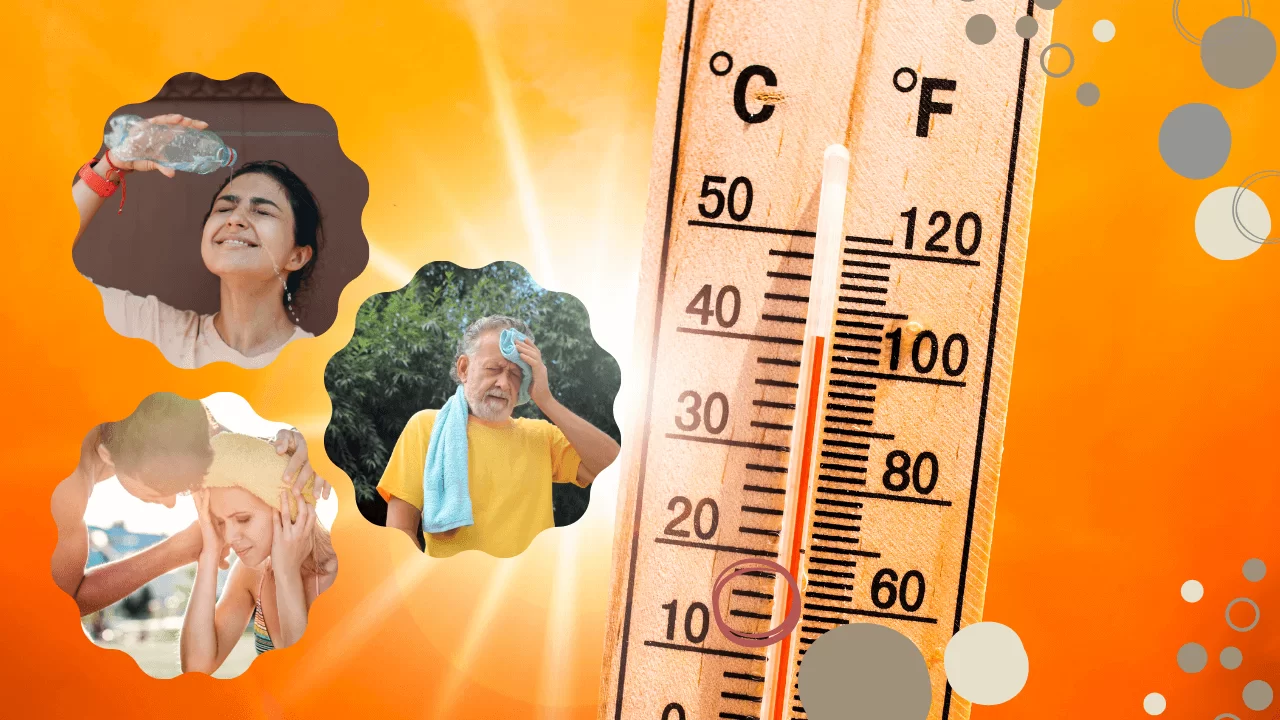Heatstroke:
Heatstroke, also known as sunstroke, is a life-threatening condition characterized by the body overheating, with a body temperature surpassing 104 degrees Fahrenheit or 40 degrees Celsius. It represents the most severe form of hyperthermia, or heat-related illness, and can result in detrimental consequences such as brain damage, organ failure, or even death.
There are two main types of heatstroke: classic heatstroke (non-exertional) and exertional heatstroke.
- Classic Heatstroke (Non-exertional Heatstroke): This type of heatstroke typically occurs in hot weather conditions, especially during heatwaves. It is often associated with older individuals, people with chronic health conditions, and those who are unable to regulate their body temperature effectively. Classic heatstroke develops gradually over time and is caused by prolonged exposure to high temperatures.
- Exertional Heatstroke: This type of heatstroke usually occurs during intense physical activity or exercise in hot and humid environments. It can affect athletes, military personnel, and individuals engaged in outdoor labor or recreational activities. Exertional heatstroke develops rapidly and is caused by strenuous exertion leading to an increase in core body temperature.
Both types of heatstroke require prompt medical attention and should be treated as medical emergencies. The risk factors, prevention strategies, and management may differ between the two types, but the primary goal remains the same: to cool the body down and prevent further complications.
Symptoms:
Symptoms of heat exhaustion include heavy sweating, weakness, dizziness, headache, nausea, and clammy skin. It is often accompanied by thirst, elevated heart rate, and low blood pressure. On the other hand, heatstroke presents with a high body temperature above 104 degrees Fahrenheit or 40 degrees Celsius, altered mental state or confusion, rapid breathing, rapid pulse, flushed skin, and potential loss of consciousness. Other signs may include headache, nausea, vomiting, seizures, and even coma. Heatstroke is a medical emergency, and immediate treatment is necessary to prevent organ damage and potential fatality.
Prevention:
Prevention of heat-related illnesses such as heat exhaustion and heatstroke involves several key measures:
- Stay hydrated: Drink plenty of fluids, especially water, throughout the day, even if you don’t feel thirsty. Avoid excessive consumption of caffeinated or alcoholic beverages as they can contribute to dehydration.
- Seek shade or cool environments: Limit your time in direct sunlight, particularly during the hottest parts of the day. If possible, stay in air-conditioned or well-ventilated spaces.
- Dress appropriately: Wear lightweight, loose-fitting clothing that allows your body to breathe and helps in the evaporation of sweat.
- Take breaks and rest: If you’re engaging in physical activity or working outdoors, schedule regular breaks in shaded or cool areas. Allow your body to rest and recover from the heat.
- Use protective measures: Wear a wide-brimmed hat, sunglasses, and apply sunscreen to protect yourself from the sun’s rays.
- Be mindful of medications: Some medications can increase the risk of heat-related issues. Consult with your healthcare provider if you are taking any medications to understand if they can affect your body’s response to heat.
- Stay informed: Pay attention to weather forecasts and heat advisories. Be aware of heat index values, which take into account both temperature and humidity, as they can provide a more accurate representation of how the heat feels.
By following these preventive measures, you can significantly reduce the risk of heat-related illnesses and enjoy the summer season safely.
Treatment:
The treatment for heatstroke involves the following measures:
- Seek immediate medical assistance: Heatstroke is a medical emergency, so it’s crucial to call for professional help or go to the nearest emergency room without delay.
- Move to a cooler environment: If possible, transfer the affected person to a shaded or air-conditioned area to lower their body temperature.
- Cool the body: Use cool water to lower the body temperature. You can spray the person with cool water, apply wet towels or ice packs to the neck, armpits, and groin areas, or immerse them in a cool bath if available.
- Encourage hydration: If the person is conscious and able to swallow, provide cool water or sports drinks to help rehydrate their body.
- Monitor vital signs: Keep an eye on the person’s breathing, pulse, and level of consciousness while awaiting medical help.
- Do not administer medications to stop shivering: Shivering is the body’s natural mechanism to generate heat and raise the core temperature. It is best to avoid using medications to stop shivering.
Remember, heatstroke is a serious condition, and professional medical care is essential for proper treatment. Prompt intervention increases the chances of a successful recovery and helps prevent complications.
Heatstroke, a potentially life-threatening condition, occurs when the body’s core temperature rises to dangerous levels due to prolonged exposure to high temperatures and inadequate heat regulation. Symptoms such as headache, dizziness, rapid heartbeat, confusion, and loss of consciousness indicate the onset of heatstroke, which requires immediate action. Prevention through staying hydrated, seeking shade, and avoiding strenuous activities during extreme heat is crucial. If heatstroke is suspected, prompt measures such as moving to a cooler place, applying cold compresses, and seeking urgent medical attention are vital to prevent permanent disability or even death associated with this alarming condition.
How do you treat heatstroke?
Immerse in cold water, utilize evaporation cooling techniques, use ice packs and cooling blankets, and administer medications to alleviate shivering.
What is the first aid of heat stroke?
The initial first aid for heatstroke includes moving the person to a cooler location, removing excess clothing, applying cool water or ice packs to the body, and seeking immediate medical assistance.
Is Heatstroke Painful?
Yes, heatstroke can be a painful condition. Common symptoms of heatstroke include intense headache, muscle cramps, nausea, dizziness, and a general feeling of weakness or discomfort. In severe cases, heatstroke can cause organ damage and even be life-threatening. It is crucial to seek medical attention immediately if heatstroke is suspected.
Is heat stroke serious?
Yes, Heatstroke is a serious condition that can lead to long-term disability or even death if not treated promptly.
Are heat exhaustion and heatstroke the same thing?
Heat exhaustion and heatstroke are distinct heat-related conditions; heat exhaustion is characterized by symptoms like heavy sweating and weakness, while heatstroke is a life-threatening condition with symptoms including high body temperature, altered mental state, and rapid pulse, requiring immediate medical attention.
What are the long effects of heat stroke?
Complications that can arise from heatstroke include organ dysfunction or failure, neurological impairment, cardiovascular complications like heart attacks or abnormal heart rhythms, respiratory distress, electrolyte imbalances, and an increased susceptibility to future heat-related illnesses.


